Volume 6, Issue 1, 2020, pp. 24-30
Nisha Shrivastava1,2, Gaurav Kumar Sharma1, Tarun Patodia2, Balram Tripathi2
1Department of Physics, Suresh GyanVihar University, Jaipur
2Department of physics, S S Jain Subodh pG (Autonomous) College, Jaipur
E-mail: balramtripathi1181@gmail.com, nishasaxena2411@rediffmail.com
Abstract
Graphene-based materials are promising for applications in super capacitors and other energy storage devices due to the intriguing properties, i.e., highly tunable surface area, outstanding electrical conductivity, good chemical stability and excellent mechanical behavior. This paper summarizes recent developments of graphene oxide-based materials for supercapacitor electrodes, based on their macro structural complexity, i.e., zero-dimensional (0D) (e.g. free-standing graphene oxide), one-dimensional (1D) (e.g. fiber-type and yarn-type structures), two dimensional (2D) (e.g. graphenes and graphene-based nanocomposite films), and three-dimensional (3D) (e.g. graphene foam and hydrogel based nanocomposites). There are extensive and on-going researches on the rationalization of their structures at varying scales and dimensions, development of effective and low cost synthesis techniques, design and architect ring of graphene-based materials, as well as clarification of their electrochemical performance.
- INTRODUCTION
Graphene oxide is an oxidized form of graphene, laced with oxygen-containing groups. It is considered easy to process since it is dispersible in water (and other solvents) and it can even be used to make graphene. Graphene oxide is not a good conductor, but processes exist to augment its properties. Graphene oxide is synthesized using Hummer’s method. Many variations of these methods exist, with improvements constantly being explored to achieve better results and cheaper processes. The effectiveness of an oxidation process is often evaluated by the carbon/oxygen ratios of the graphene oxide. Composite electrodes integrate two or more materials together as active charge storage materials. Most popular approach is to fabricate composites between carbon based materials with pseudo capacitive. Graphene oxide is considered as one of the most promising material for the next generation flexible thin film super capacitors due to its unique structural and property features, i.e. i) the two-dimensional structure can provide a large surface area, which serves as an extensive transport platform for electrolytes ii) the high conductivity enables a low diffusion resistance, therefore leading to enhanced power and energy density; and iii) the superior mechanical property makes free-standing films with robust mechanical stability. Among the carbon based 2D materials graphene oxide has attracted much attention due to tunable thickness, structural flexibility, lightweight and electrical properties, which are the essential qualities required for flexible super capacitors. Considerable research efforts have been therefore dedicated to exploring novel processing methods for graphene oxide based , including spin-coating Langmuir Blodgett, layer-by-layer deposition, interfacial self-assembly, and vacuum filtration .
Polymers are substances containing a large number of structural units joined by the same type of linkage. These substances often form into a chain-like structure. Polymers already have a range of applications that far exceeds that of any other class of material available to man. Current applications extend from adhesives, coatings, foams, and packaging materials to textile and industrial fibers, composites, electronic devices, biomedical devices, optical devices, and precursors for many newly developed high-tech ceramics.
Polystyrene(PS)Schematic: Density: 1.05 g/cm Melting point: 240°C (464°F)Chemical formula: (C8H8)n
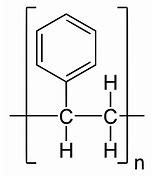
Polystyrene is a linear or branched polymer with little or no cross-linking. As a result, they are thermoplastic materials, which flow easily when heated and can be molded into a variety of shapes. Polystyrene (PS) is one of the most widely used commercial polymer. The integration of functionalized graphene in a PS matrix produced nanocomposite thin films that are semiconducting and exhibit an ambipolar field effect . In order to upgrade the properties of polystyrene and reach desired polymer-graphene interaction. Nanocomposites are the matrices in which nanoparticles have been added to improve properties of the material.Nanocomposites in which the interface of graphene oxide based materials and polymer chains merge to develop the most technologically promising devices. Energy storage is a primary focus of the major world powers and scientific community. A new technology, the electrochemical capacitor or the super capacitors, have emerged with the potential to enable major advances in energy storage. It is governed by the same fundamental equations as conventional capacitors, but utilize higher surface area electrodes and thinner dielectrics to achieve greater capacitances. This allows for the energy densities greater than those of conventional capacitors and power densities greater than those of batteries. As a result, it may become an attractive power solution for an increasing number of applications.
As one of the limitation to the capacitance of super capacitors is the surface area of the conductors. If the conductive material like GO having higher relative surface area could be use in a supercapacitors than it will be better for storing electrostatic charge. Also, it is lighter and eco-friendly unlike most other forms of energy storage.
- EXPERIMENTAL
In the present study we have synthesize Graphene oxide (GO) by Hummer’s method and its composites with Polystyrene (PS) by solution cast method with different concentrations in the form of thin films(samples).We have study some important characteristics of these samples like bonding behaviour by FT-IR spectroscopy, dielectric constant by impedance spectroscopy and behaviour and optical characteristics by UV-Vis spectroscopy.
- RESULTS AND DISCUSSION
In this study results of GO/polystyrene nanocomposites with varying concentration of graphene oxide have been presented. Fig.1 & Fig.2 show dielectric constant values ranging (1.2 to 4.80) of GO and rGO dispersed polystyrene composites respectively. Fig.3 represents FT-IR characteristics of GO-polystyrene and rGO-polystyrene nanocomposites respectively. It has been found that by dispersing grapheme oxide in the polystyrene matrix showing stretched bonding behaviour. Fig.4 represents UV-Vis spectra of GO-poystyrene nanocomposite. From fig 4, it is clear that optical absorbance has been found to be increased on increasing concentration of GO in the polystyrene matrix.
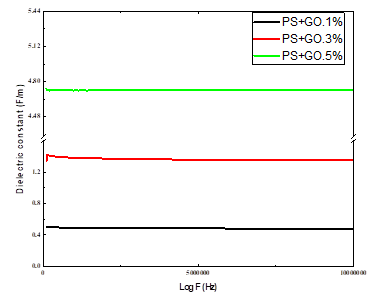
Fig. 1. Dielectric Constant for PS-GO composites
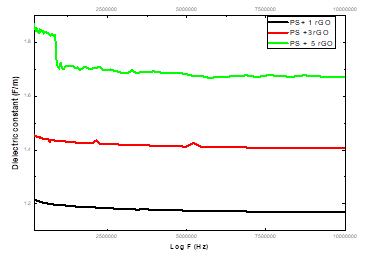
Fig. 2. Dielectric constant for PS-rGO composites
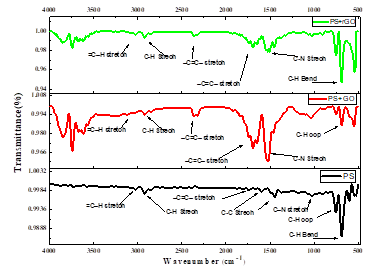
Fig. 3 FTIR plot for PS-GO and PS-rGO composites
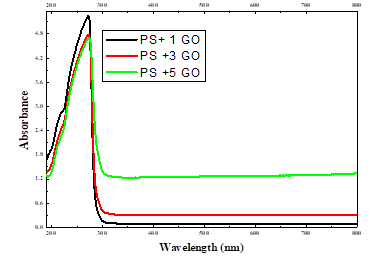
Fig 4. UV-VIS for PS-GO composites
- CONCLUSION
It is concluded from above study that GO dispersed polystyrene nanocomposites are promising materials for supercapacitors application with highly tunable surface area, outstanding electrical conductivity, good chemical stability and excellent mechanical behaviour.
REFRENCES
- Liang JJ, Huang Y, Oh J, Kozlov M, Sui D, Fang SL, et al. Electromechanical actuators based on graphene and graphene/Fe3O4 hybrid paper. AdvFunctMater 2011;21:3778e84
- Becerril HA, Mao J, Liu Z, Stoltenberg RM, Bao Z, Chen Y. Evaluation of solution rocessed reduced graphene oxide films as transparent conductors. ACS Nano 2008;2:463e70
- Shao Y, El-Kady MF, Wang LJ, Zhang Q, Li Y, Wang H, Mousaviae MF, Kaner RB. Graphene-based materials for flexible supercapacitors. Chem. Soc. Rev http://dx.doi.org/10.1039/c4cs00316
- Gϋnes F, Shin HJ, Biswas C, Han GH, Kim ES, Chae SJ, et al. Layerby-layer doping of few-layer graphene film. ACS Nano 2010;4:4595e600
- Gan S, Zhong L, Wu T, Han D, Zhang J, Ulstrup J, et al. Spontaneous and fast growth of large-area graphenenanofilms facilitated by oil/water interfaces. Adv Mater 2012;24:3958e64.
- Li D, Muller MB, Gilje S, Kaner RB, Wallace GG. Processable aqueous dispersions of graphene nanosheets. Nat Nanotechnol 2008;3:101e5 Cai Y, Zhang G, Zhang YW. Polarity-reversed robust carrier mobility in monolayer MoS2 nanoribbons. J Am ChemSoc 2014;136:6269e75.
- Frackowiak E, Khomenko V, Jurewicz K, Lota K, Beguin F. Supercapacitors based on conducting polymers/nanotubes composites. J Power Sources 2006;153:413e8.
- D. Meryl, P. Sungjin, Z. Yanwu, A. Jinho and R.S.Rodney, “Graphene- BasedUltracapacitors”, Nano letters, Vol.8, No. 10.2008pp.3498-3502
- Jingquan Liu, Zhen Liu , Colin J. Barrowb, Wenrong Yang (July 2014) Molecularly engineered graphene surfaces for sensing applications
- Vangari, Manisha (Sep. 2012 ) “Supercapacitors: Review of Materials and Fabrication Methods”http://soi.org/10.1061(ASCE)Ey.1943-7897.0000102 Vol 139
- Zhangpeng Li Flexible graphene/MnO2 composite papers for supercapacitor electrodes DOI: 10.1039/C1JM11941A(2011)
